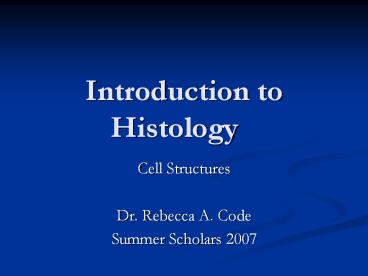Introduction to Histology - PowerPoint PPT Presentation
1 / 20
Title:
Introduction to Histology
Description:
Histology the study of cellular structures of the body ... Occluding the most apical junction. Zonula occludens, tight junctions. Adhering 2 types: ... – PowerPoint PPT presentation
Number of Views:305
Avg rating:3.0/5.0
Title: Introduction to Histology
1
Introduction to Histology
- Cell Structures
- Dr. Rebecca A. Code
- Summer Scholars 2007
2
Histology the study of cellular structures of
the body
- Anatomy at the microscopic level (microanatomy)
- Cells---tissues---organs---organ systems
- 1015 cells in the human body
- 200 cell types in the body
Observation the key to identifying cell types
3
Nucleus present in almost all cells, stains
well with hematoxylin.
- Size
- Shape
- Location
- Number
- Nucleolus site of rRNA synthesis
- Density
- Euchromatic light staining nucleus due to
regions of chromosomes that are less coiled,
indicating that the DNA is actively transcribing
mRNA. - Heterochromatic dense, darkly staining nucleus
due to tightly coiled chromatin, presumably not
transcriptionally active.
4
Cytoplasmic organelles other clues to
differentiate cell types and function
- Ribosomes
- Mitochondria
- Golgi apparatus
- Endoplasmic reticulum
- Microfilaments
- Secretory vesicles
- Pigment granules
- Lipid droplets
5
Cell Specializations
- Microvilli found on many epithelial cells 1-2
mm long extensions of cell membrane increase
surface area (15-20X) for absorption lots of
microvilli brush border - Cilia 7-10 mm long motile structures
stabilized by microtubules function to move
fluid over cells found in trachea, bronchi,
oviducts, flagella of sperm. - Stereocilia very long microvilli, non-motile
for absorption in epidydimus and on hair cells
of inner ear.
6
Microvillus
Cilium
7
Cell Adhesions/Junctions
- Nearly all cells are connected to neighboring
cells by cell junctions - Occluding junctions join cells together to form
impermeable barrier - Adhering junctions provide mechanical attachment
between cells. - Communicating junctions permit movement of ions
or molecules between cells
8
Cell Junctions
- Occluding the most apical junction
- Zonula occludens, tight junctions
- Adhering 2 types
- Zonula adherentes
- Macula adherens desmosomes
- Communicating
- Gap junctions
9
Histology 2 dimensional image
- A section is a slice of tissue
- Orientation when sectioned affects what you see.
10
Section of Round Solid Object
A
B
A
B
11
Sections cut through a curved tube
12
Light Microscope tool of the histologist
- Oculars (eyepieces)
- Stage
- Objective Lens
- Condenser
- Light source
- Focus knobs
13
Specimen Preparation
- Fixation, dehydration, embedding
- Sectioning
- Staining most common is HE
- Hematoxylin cationic dye ( charge) that binds
to negatively charged (acidic) structures in the
cell. Example nucleus blue - Eosin anionic dye (- charge) adheres to basic
structures in the cell. Example amine groups
(NH3) on proteins make cytoplasm pink.
14
Kidney cells
15
Heterochromatic and Euchromatic Nuclei
16
Golgi Apparatus in Nerve Cells
17
Mitochondria and Myofibrils
18
Microvilli of Intestinal Epithelial Cells
19
Cilia of Tracheal Epithelial Cells
20
False Intercellular Bridges (Desmosomes)































